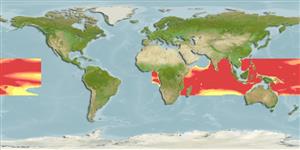Common names from other countries
Environment: milieu / climate zone / depth range / distribution range
Ecologie
Bathypelagisch; diepteverspreiding 200 - 3716 m (Ref. 96667). Deep-water; 20°N - 24°S, 2°E - 131°W (Ref. 97331)
Indo-Pacific.
Length at first maturity / Size / Gewicht / Leeftijd
Maturity: Lm ? range ? - ? cm Max length : 2.5 cm CL mannelijk/geslacht niet bekend; (Ref. 97331); 2.3 cm CL (female)
The large and stout body is covered uniformly with fine pits, which are marks of the attachment of small lanceolate scales. The rostrum is usually shorter than the carapace. The branchiostegal spine is small, supported by a very small carina. A distinct dorsal carina is present on the second to sixth abdominal somites. The carinae of the third to sixth somites ends in large teeth. The telson bears 3 pairs of dorsolateral spines.
Minimum depth from Ref. 96741.
Life cycle and mating behavior
Geslachtsrijpheid | Voortplanting | Kuitschieten | Eieren | Fecundity | Larven
Members of the order Decapoda are mostly gonochoric. Mating behavior: Precopulatory courtship ritual is common (through olfactory and tactile cues); usually indirect sperm transfer.
Poupin, J. 1998. (Ref. 75706)
Status op de Rode Lijst van het IUCN (Ref. 130435)
Status bij CITES (Ref. 108899)
Not Evaluated
Not Evaluated
Gevaarlijk voor mensen
Harmless
Gebruik door de mens
| FishSource |
Tools
Internet-bronnen
Estimates based on models
Preferred temperature
(Ref.
115969): 2.9 - 7.4, mean 4.4 (based on 1123 cells).
